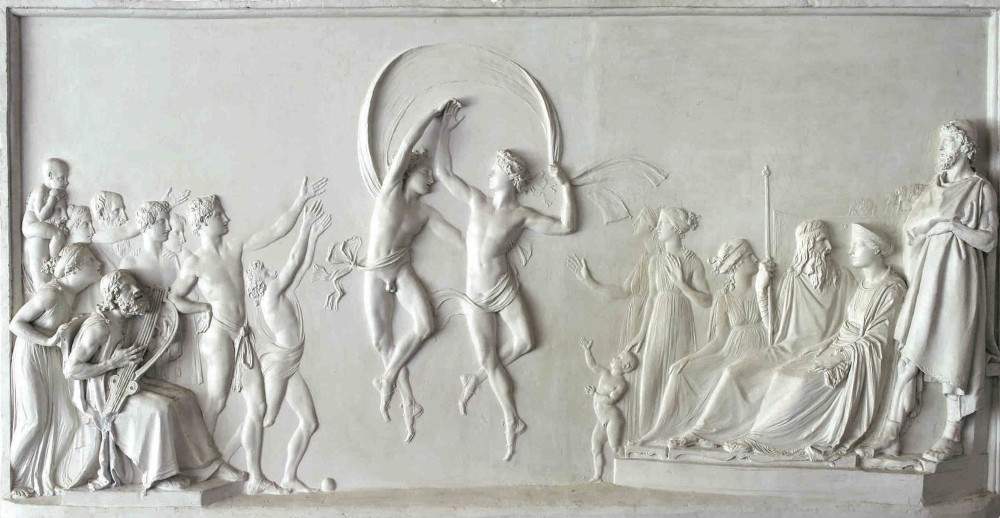From July 6 to November 1, 2022, the exhibition Al tempo di Canova. An Umbrian Itinerary, curated by Stefania Petrillo and organized by the “Pietro Vannucci” Academy of Fine Arts and the Perugia Foundation.
Perugia celebrates the bicentenary of Antonio Canova’s death with this exhibition-itinerary. Focusing on the nucleus of Canova’s plaster casts preserved at MUSA, including The Three Graces, donated by the sculptor himself in 1822, the exhibition aims to enhance the artistic and cultural context within which these works were inserted, telling of an Umbria included in wider dynamics and a lively network of relationships. “They form chain and collection,” Canova explained to Napoleon in 1810 to dissuade him from taking more masterpieces from Italy and emphasizing the importance of the link established between the works and their original places. The basic principle of the Perugia exhibition is precisely this: to highlight what orbits between the eighteenth and nineteenth centuries around the"Umbrian Canova“: a connective tissue vitalized by an incessant exchange with the ”University of the Arts" that is Rome and by a circulation of ideas and taste that inserts Umbria into a larger community of arts, letters and thought.
The exhibition is divided into seven thematic sections: Papal Umbria, The Napoleonic Season, The Landscape, Canova and the Academy of Fine Arts of Perugia, “Another Line of Beauty”: toward Purism, The Engravings, Canova’s Legacy.
There are many new features in this exhibition conceived as a journey through time, with more than 100 works intended to recount the sister arts spread in an era that cultivated beauty: sculpture, architecture, painting, even in papal and Napoleonic Umbria were participants in that “happy revolution of the arts” that had Canova as its absolute protagonist.
Among the artists on display, along with Canova, are Giuseppe Valadier, Vincenzo Pacetti, Carlo Labruzzi, Pietro Labruzzi, Cristoforo Unterperger, Abraham-Louis-Rodolphe Ducros, Stefano Tofanelli, Tommaso Maria Conca, Pietro Benvenuti, Vincenzo Camuccini, Jean-Baptiste Wicar, Tommaso Minardi, and Giovanni Sanguinetti. Canova, the “modern classic,” was acclaimed by pontiffs, sovereigns, academies and collectors throughout Europe. The sculptor, who in Umbria owned a palace in San Gemini with vast estates, also established non-ephemeral relations with many members of the local ruling class, intellectuals, high prelates, and collectors, in a common vision of art as a factor of education to the highest aesthetic and civic values.
The exhibition itinerary, real and ideal, will have small and large"post stations" around works and protagonists of a season that culminated in the influential link Canova had between 1812 and 1822 with thePerugia Academy of Fine Arts, whose choices he directed, supporting the appointment of directors such as Carlo Labruzzi, Tommaso Minardi, and Giovanni Sanguinetti.
The real surprise, however, consists in one of the works bequeathed to the Academy by Canova’s half-brother Giovanni Battista Sartori, the colossal horse’s head, a model of the equestrian monument to Ferdinand I of Bourbon, “rediscovered” on this occasion: it will be displayed at Palazzo Baldeschi in an unprecedented comparison with the horse’s head of Marcus Aurelius, the cast made and taken as a model by Canova, now in Ravenna.
Two different admission tickets are provided to visit the two exhibition venues. Palazzo Baldeschi and MUSA apply a reciprocal reduction on tickets: visitors who come to one of the exhibition venues with a ticket from the other will be entitled to reduced admission.
The exhibition is accompanied by a catalog published by Aba Press, printed by Fabbri Editore.
Image: Antonio Canova, La Danza dei figli di Alcinoo (1790-1792; Perugia, Fondazione Accademia di Belle Arti “Pietro Vannucci”)
 |
| Perugia dedicates an exhibition to Antonio Canova on the bicentenary of his death, at two venues |
Warning: the translation into English of the original Italian article was created using automatic tools. We undertake to review all articles, but we do not guarantee the total absence of inaccuracies in the translation due to the program. You can find the original by clicking on the ITA button. If you find any mistake,please contact us.